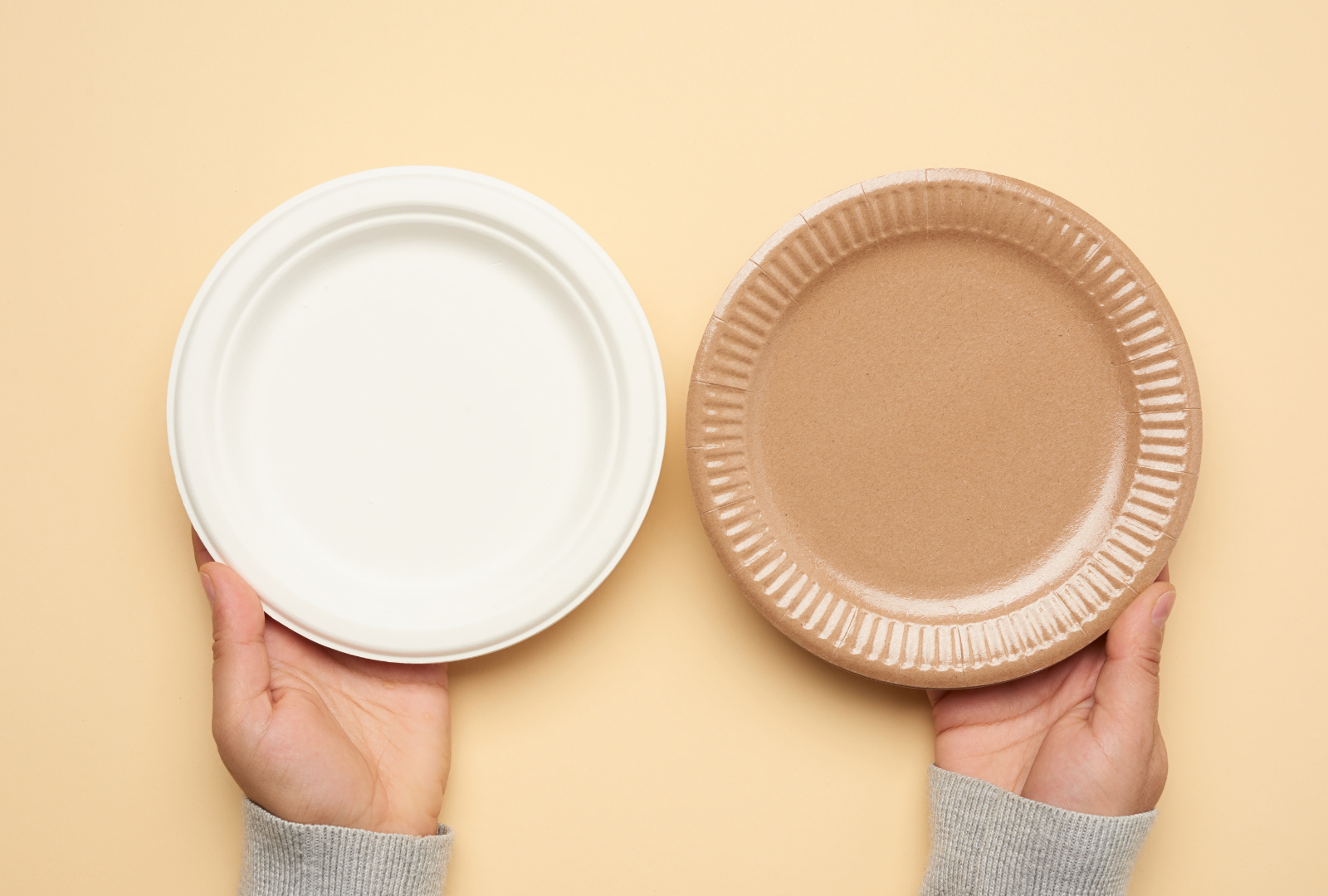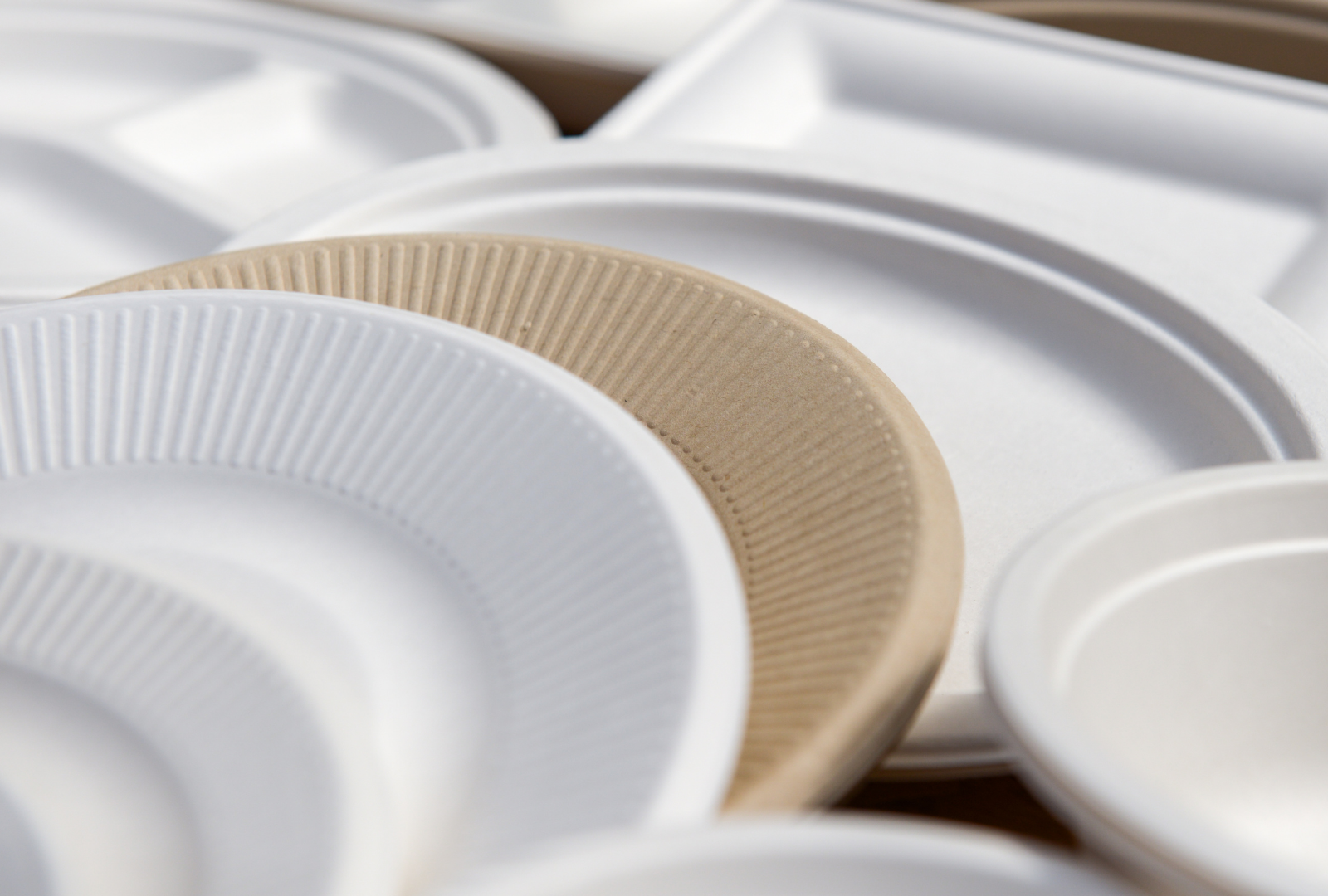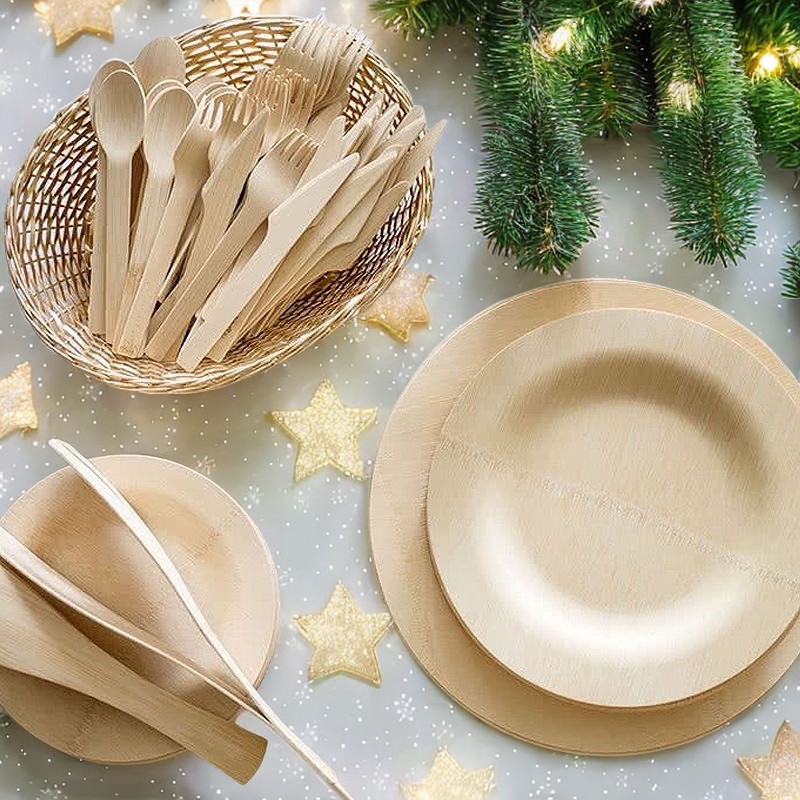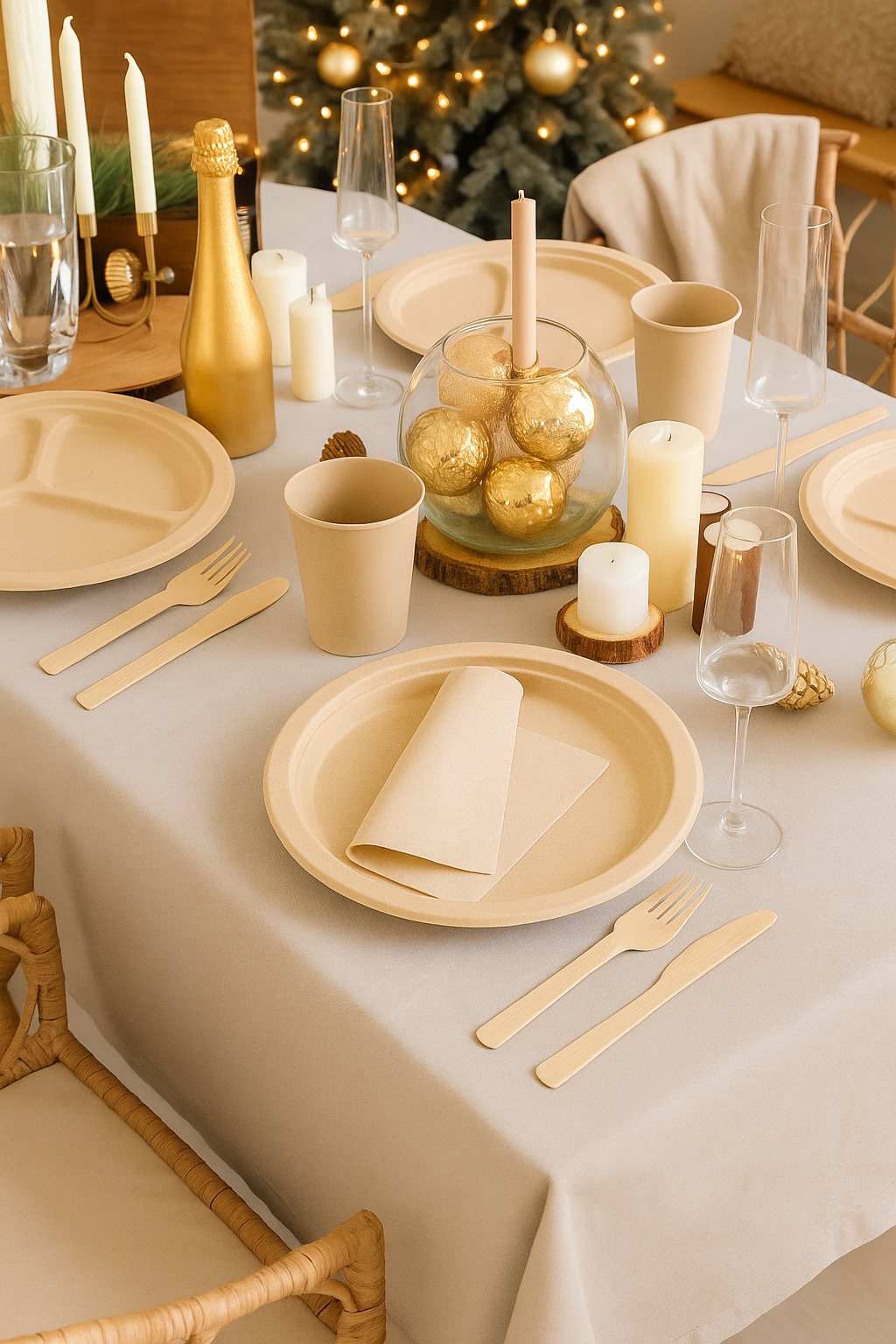
When choosing disposable plates, finding the right material is key. The wrong choice can impact both the environment and your budget.
What are the best materials for disposable plates? Let’s explore the options, from plastic to bamboo, and find the right balance between eco-friendliness and functionality.
Picking disposable plates can be confusing. There are many options to consider, and each has its pros and cons. Understanding the materials helps make the right decision for your needs.
1. Introduction: Importance of Choosing the Right Disposable Plate Material?
The growing demand for disposable plates is obvious. They are needed for foodservice, events, takeaways, and many other occasions. But with increasing environmental concerns, the pressure to find sustainable alternatives is also rising.
Why is it important to choose the right material for disposable plates? It’s not just about cost—it’s about balancing functionality, sustainability, and environmental impact. The material you choose will influence everything, from durability to waste disposal.

There are various materials available, each with its own advantages and disadvantages. Plastic, paper, bagasse, bamboo, and palm leaf all offer different benefits. In this section, I will give a detailed comparison of the most common materials.
2. Overview of Common Disposable Plate Materials?
How do different materials compare for disposable plates? Here’s a breakdown of the most common materials used in the industry today.
Plastic Plates:
- Pros: Durable, low-cost, and good for holding heavy or greasy foods.
- Cons: Non-biodegradable, a major contributor to pollution, and not suitable for environmentally conscious brands.
Paper Plates:
- Pros: Lightweight, affordable, and easy to dispose of.
- Cons: Often coated with a plastic layer for added strength, which compromises biodegradability and recyclability.
Bagasse Plates (Sugarcane Fiber):
- Pros: Made from sugarcane pulp, a renewable byproduct, and is compostable.
- Cons: Some may have a coating that reduces compostability. The durability is limited compared to plastic.
Palm Leaf Plates:
- Pros: Fully compostable, made from fallen palm leaves, and naturally sturdy.
- Cons: Availability can be inconsistent due to seasonal harvesting.
Bamboo Plates:
- Pros: Renewable, durable, biodegradable, and often aesthetically appealing with natural grain.
- Cons: Slightly more expensive than paper or plastic alternatives, though the quality and environmental benefits outweigh this.

Which Material is Best for You?
When comparing these materials, it’s important to consider several factors: durability, environmental impact, and cost.
Plastic Plates
Plastic is often the go-to choice because it is inexpensive and incredibly durable. It can hold a lot of weight and doesn’t absorb liquids easily, making it suitable for a wide range of foods. However, plastic is a major environmental problem. It’s non-biodegradable, which means it takes hundreds of years to break down. The impact on wildlife and ecosystems is devastating, and many countries are introducing bans to reduce plastic usage. As a result, using plastic plates is becoming less viable, especially in places with environmental regulations.
| Material | Sustainability | Durability | Cost | Compostability | User Appeal |
|---|---|---|---|---|---|
| Plastic | Low | High | Low | No | Medium |
Paper Plates
Paper plates are often seen as a better option compared to plastic. They’re lightweight and cheap. However, many paper plates are coated with plastic to add strength, which makes them non-compostable. In addition, they don’t perform as well under heat or moisture, leading to potential leaks or breakage when serving hot, greasy, or liquid-heavy foods.
| Material | Sustainability | Durability | Cost | Compostability | User Appeal |
|---|---|---|---|---|---|
| Paper | Variable | Low-Medium | Low | Sometimes | Low |
Bagasse Plates
Bagasse plates are made from sugarcane fiber, which is a byproduct of sugar production. These plates are eco-friendly and compostable, which makes them an attractive choice. However, they’re not as durable as plastic, especially for greasy or heavy foods. Additionally, some manufacturers coat their bagasse plates with harmful chemicals that reduce compostability.
| Material | Sustainability | Durability | Cost | Compostability | User Appeal |
|---|---|---|---|---|---|
| Bagasse | Medium | Medium | Moderate | Usually Yes | Low-Medium |
Palm Leaf Plates
Palm leaf plates are a more natural, sturdy option. Made from fallen palm leaves, they are fully compostable and biodegradable. These plates are great for dry foods and can handle both hot and cold items well. However, their main drawback is availability, as they depend on seasonal harvesting. They also tend to have a rustic, more natural look, which may not suit every event or brand.
| Material | Sustainability | Durability | Cost | Compostability | User Appeal |
|---|---|---|---|---|---|
| Palm Leaf | High | Medium-High | Moderate | Yes | Medium |
Bamboo Plates
Bamboo is one of the best choices for disposable plates. It is renewable, biodegradable, and durable. Bamboo grows quickly without deforestation, making it a highly sustainable material. Bamboo plates are heat-resistant and can hold both hot and cold foods. Unlike plastic and paper, bamboo plates don’t need coatings, making them safer for food use. They also have an appealing natural grain that adds to the visual appeal of any setting.
| Material | Sustainability | Durability | Cost | Compostability | User Appeal |
|---|---|---|---|---|---|
| Bamboo | High (Renewable) | High | Moderate | Yes | High |
3. Bamboo Plates: Why They Often Rank as the Best Choice?
Why do bamboo plates often come out on top in comparisons? There are several factors that contribute to bamboo’s growing popularity in the disposable tableware market.
Sustainability
Bamboo is one of the fastest-growing plants in the world. It can be harvested without causing deforestation, making it a highly renewable resource. Unlike plastic, bamboo is biodegradable, meaning it breaks down naturally in the environment, reducing waste and landfill buildup.
Durability and Usability
Bamboo plates are designed to handle both hot and cold foods, making them versatile. They are heat-resistant and moisture-resistant, so they won’t become soggy or bend under the weight of hot foods. They offer strength and durability, unlike paper plates, which are prone to leaks.
Safety
Unlike some plastic and paper alternatives, bamboo plates do not contain harmful chemicals or coatings. This makes them a safe choice for food contact, with no odor or taste transfer.
Compostability
Bamboo plates break down naturally in 3 to 6 months when composted under proper conditions. This quick decomposition time makes bamboo an excellent choice for eco-conscious businesses.
Visual Appeal
Bamboo has a natural, elegant grain that makes it a popular choice for upscale events or businesses looking to enhance their brand image. The aesthetic appeal adds a touch of sophistication to any setting, making it perfect for eco-conscious establishments.

Bamboo’s Growing Popularity in Eco-Friendly Markets
Bamboo plates are becoming a go-to option for businesses that want to align themselves with sustainability. But why is bamboo seeing such a rise in demand? It’s a combination of environmental impact, cost-effectiveness, and versatility that is hard to match.
Why Bamboo is the Future
As plastic bans become more widespread and consumers demand more sustainable products, bamboo has emerged as the material of choice. It’s easy to source, inexpensive, and produces minimal waste, which makes it a perfect fit for companies committed to sustainability.
4. Material Comparison Table
| Material | Sustainability | Durability | Cost | Compostability | User Appeal |
|---|---|---|---|---|---|
| Bamboo | High (Renewable) | High | Moderate | Yes | High |
| Palm Leaf | High (Fallen Leaves) | Medium-High | Moderate | Yes | Medium |
| Bagasse | Medium (Agri Byproduct) | Medium | Moderate | Usually Yes* | Low-Medium |
| Paper | Variable (Coated) | Low-Medium | Low | Sometimes | Low |
| Plastic | Low (Non-Renewable) | High | Low | No | Medium |
5. Key Factors to Consider When Choosing Disposable Plates?
There are several factors to consider when choosing the best disposable plates for your business. Here are some of the most important ones:
- Environmental Impact: Many businesses are under pressure to reduce waste and adopt sustainable practices. Consider the environmental footprint of the material you choose.
- Durability Needs: Will your plates be used for hot, greasy, or heavy foods? Ensure the material can hold up to the demands of your business.
- Cost-Effectiveness: Consider the long-term cost of purchasing disposable plates in bulk. Sustainable materials might cost more upfront but can be a better choice in the long run.
- Brand Alignment: Does your brand align with sustainability goals? Eco-conscious customers may appreciate your commitment to using biodegradable products.
6. Why Choose PANABAM Bamboo Disposable Plates?
At PANABAM, we provide high-quality bamboo plates that cater to all your needs. With over 10 years of experience and cutting-edge automated production lines, we are a leader in the bamboo tableware market.
Why choose us?
- Over a decade of factory expertise with smart production lines.
- High-quality bamboo fiber processing ensuring product safety and durability.
- Compliant with international food safety and environmental standards.
- Flexible MOQ and customizable design options to suit your needs.
- Reliable supply chain with global export experience.
7. Conclusion: Bamboo Plates as the Optimal Choice for Sustainable Disposable Tableware
Bamboo plates offer the perfect combination of sustainability, functionality, and cost-effectiveness. Their growing popularity in eco-conscious markets is well-deserved, as they not only meet environmental needs but also enhance your brand image.
Adopting bamboo disposable plates is a great way to step into a more sustainable future. Connect with PANABAM today to explore how our products can meet your business needs and help you transition to a greener alternative.
FAQ
What is the best material for disposable plates?
The best material depends on your needs. Bamboo is often considered the best because it is durable, eco-friendly, and compostable. Bagasse and palm leaf are also good sustainable options. Plastic is durable but not environmentally friendly.
What is the best material for dinnerware plates?
For long-term dinnerware, porcelain, ceramic, or tempered glass are often the best choices. They are safe, durable, and resistant to scratches. For disposable dinnerware, bamboo and palm leaf provide the best balance of safety and sustainability.
What is the safest disposable plate?
Bamboo and palm leaf plates are among the safest. They are free from harmful coatings and chemicals, safe for food contact, and fully biodegradable. Paper plates can also be safe if uncoated and certified for food use.
Is it better to use paper or plastic plates?
Paper is generally better than plastic for environmental reasons. However, coated paper plates may not be compostable. Plastic plates are strong but harmful to the environment. Bamboo or bagasse are better alternatives than both.
What material plates don’t scratch?
Porcelain, tempered glass, and high-quality bamboo plates resist scratches well. Melamine is also scratch-resistant, though it is not biodegradable. Lower-quality plastic and coated paper plates scratch more easily.
What is the safest plate material to eat off of?
Glass, porcelain, stainless steel, and bamboo are among the safest. They do not leach harmful chemicals, resist heat, and are food-safe. Avoid low-quality plastic or melamine for hot foods due to safety concerns.
Who makes the best paper plates?
Well-known brands like Dixie and Chinet are recognized for sturdy paper plates. However, eco-conscious buyers often prefer bagasse or bamboo options from sustainable manufacturers like PANABAM, as they combine strength with biodegradability.
What’s the difference between coated and uncoated paper plates?
Coated paper plates have a thin layer of plastic or wax to prevent leaks and improve durability. However, this coating makes them non-compostable. Uncoated paper plates are more eco-friendly but less resistant to moisture and grease.

Ann
Hi, I’m Ann, and with over 5 years of experience in the foodservice industry, I’ve had the pleasure of working with restaurants and catering businesses to develop eco-friendly, tailored solutions that help you thrive in today’s green economy. I’m passionate about sustainability and committed to providing high-quality products that align with your values.
If you’re looking to make the switch to eco-friendly, sustainable tableware, I’m here to help! Reach out today, and let’s explore how we can support your business’s goals while contributing to a healthier planet.

